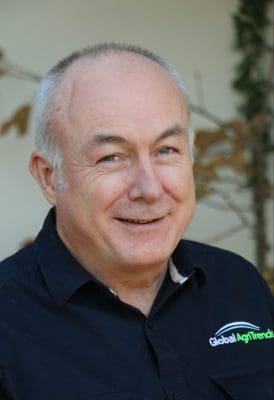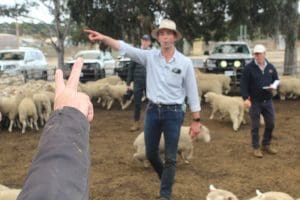
Simon Quilty.
LAMB prices regularly hit 1000c/kg in pre-Christmas saleyard sales this week, but within two years Global AgriTrends analyst Simon Quilty believes this will be the average price processors will be paying.
Discounting surveys or analysts that estimate little change in the nation’s ewe or lamb flock – he believes years of high ewe slaughter will turn the supply-demand cycle in producers’ favour for mutton and lamb prices for the next 2-3 years.
He is disappointed at the lack of current Australian Bureau of Statistics census-derived sheep and cattle and producer numbers, while producer surveys with small samples have led to extrapolations that tend to overestimate flock and herd size.
And anecdotal evidence points to a significant deficit in lamb production, and higher ewe mortality this year, due to seasonal difficulties in some states – especially in western Victoria and south-east South Australia among pre-July lambing flocks, though less so among spring lambers.
Mr Quilty said the last official ABS flock number was released three years ago in June 2022 — 70.2 million — for the year 2021-22, meaning analysts have been left to use slaughter records and incomplete industry surveys on lamb production and ewe numbers to predict flock size.
“We’re working on scant information at best and this is embarrassing.
“Thinking on a global basis we are the largest producer of sheep meat in the world and yet we don’t have any reliable idea what the size of our flock is today,” he said.
Although the latest MLA-AWI producer intentions survey had its highest ever response rate of 10 per cent – represented by 2549 producers – “it’s still not much” compared to the coverage of the compulsory ABS Census, Mr Quilty said.
“We’re still working from very small survey pools and we know the quality of the questionnaires is what matters,” Mr Quilty said.
Despite the intention survey’s highest-ever response rate, the result means 90 percent of sheep producers contacted did not reply to the intentions survey, and the number of producers who did not respond because they had left the industry or intended to leave could not be calculated. Nor did the survey calculate ewe mortality, nor how many producers might have been forced – due to feed or other costs — to sell ewe lambs or older sound mouth ewes for slaughter they had intended to mate.
And although the producer intentions survey indicated sentiment among sheep meat respondents has increased 84 points over the past twelve months, Mr Quilty believes there has been a crisis of confidence in the sheep industry not brought out by the survey, but apparent from talking to agents and producers across the country.
Mutton kill is a better indicator
In lieu of an up-to-date ABS census-derived producer number and flock size, Mr Quilty believes the better indicator flock rebuild and liquidation is the mutton kill itself.
“There are almost no wethers retained in the Australian flock, so the mutton kill is basically the female kill and represents the flock itself, in terms of whether it is liquidating or not, because effectively it is the breeders that are being slaughtered for mutton.”
And more recently anecdotal reports indicate the slaughter of ewes has extended at times into productive older ewes and ewe lambs, especially in times of seasonal, price and cost of production difficulties in Victoria, South Australia and Western Australia.
Mr Quilty said large mutton slaughters had traditionally been related to a much high national flock size, whereas the mutton slaughter last year of 9.7 million and of over 10 million this year is a bigger percentage of the overall flock.
“It is probably going to come in closer to 11 million for the year, so that’s two very heavy years in a row of mutton slaughter.”
Mr Quilty’s break-even figure between rebuild and liquidation is a 7.9 million mutton slaughter.
“So we’ve had two heavy years of liquidation and it is going to result in less numbers next year and the year after, and probably the year after that.”
Mr Quilty believes Australia is on track for a 30 percent fall in mutton kill next calendar year.
“If you kill your breeding stock you are going to have less the year later and we’ve had two years in a row of very very heavy kills.”
Mr Quilty said he is not convinced by estimations of a larger flock size.
“I think this is genuine liquidation and we’ve now got a kill in excess of 20.7 million head over two years and that far exceeds what we did in the drought of 2018-19.”
Lamb slaughter forecasts
Mr Quilty sees this meaning higher prices for lamb and mutton, and dramatically declining lamb production over the next three years. This year he estimates lamb slaughter will be 26.3 million.
“I expect that the lamb slaughter will go from 25 million this year to 24 million next year.
“And the real fall (in lamb slaughter) I think is going to be felt in 2026 when we go to 20m and probably in 2027 to in the vicinity of 19.5 million.”
Mr Quilty said the high lamb kill this year points to a lot of ewe lambs being brought to slaughter, meaning they will be unavailable for joining.
“And when I talk to agents across the country, and in recent weeks, at the Elders conference in NSW, and other agents, the genuine sentiment is exactly that — female lambs have gone to slaughter.
“Unfortunately we are basing so much of this on anecdotal evidence, but if you look at just how extraordinarily high it was, it has to be the case.”
Confidence in surveys versus exit numbers
Mr Quilty said despite surveys indicating improved producer confidence, he has been told by non-bank lenders that beef and sheep client confidence is extremely low.
From ABS figures from 2021 to 2022 he said it can be seen that 15pc of wool or specialist sheep producers exited the industry. Some figures are due soon, comparing 2024 to 2022 and he believes the exit percentage will be considerably higher.
Mr Quilty said his contacts indicate the number of sheep producers in NSW that left the industry last year was significant.
“(The season in) October and November hurt a lot of people financially and in terms of mental health and in many cases light lambs were euthanized, it just wasn’t spoken of and you only ever do it once.”
Mr Quilty said it worries him most industry surveys conclude that producer confidence is mostly improved.
“That worries me when there is lots of other evidence – whether it be slaughter or business registrations – that points to producers exiting the industry.”
Mr Quilty said about 80 people enrolled on a webinar – agents, lot feeders, producers, pastoral houses and processors – who believed there was adequate capacity to handle the higher slaughter throughputs in beef and sheep markets.
“But I think eventually we are going to see a tightening of supply because we are basically killing a bit of the future here.”
Lamb and mutton price forecasts
 Mr Quilty said his average price for trade lambs is estimated at 727c/kg this year, rising 18pc to an average of 860c/kg for next year, reaching a 1000c/kg average in 2026, and between 980-1050c/kg in 2027, falling to 660c/kg in 2028 as the boom cycle busts.
Mr Quilty said his average price for trade lambs is estimated at 727c/kg this year, rising 18pc to an average of 860c/kg for next year, reaching a 1000c/kg average in 2026, and between 980-1050c/kg in 2027, falling to 660c/kg in 2028 as the boom cycle busts.
“It’s about going from killing 37 million of smallstock to 25 million in two years.”
His averages for heavy lamb are around 750c/kg this year, rising 23pc to 925c/kg next year, to 1150c/kg in 2026 and in line with the trade lamb prices at 1050c/kg, with a significant tightening of supply.
“I think there has been a massive exodus out of the industry and as a result of that, even at these prices, will be reluctant to come back in.”
Mr Quilty believes seasonal finishing challenges have caused a migration of lamb production into Victoria from New South Wales, with crucial development of lot feeding in both states.
“We think that there is somewhere around 6 million head of lambs will go on feed this year and next, it could get as high as 8 million.
“That’s related to the desire for heavier lambs, but also NSW has become truly challenged by its unpredictable weather conditions meaning a need to find other lamb finishing solutions.”
He said a lot of lambs have been moving into Victoria to be slaughter or to be finished on grass.
On mutton, Mr Quilty estimates an average price this year of 330c/kg, rising to 500c/kg in 2025, and increasing again in 2026 to average 750c/kg, with rates starting to fall into 2027 to around 620c/kg.
“I just think that this year and last year were extraordinary years of liquidation and as a result you’ve got to pay the piper.
“And it will be not just for the following two years 2025 and 2026, it will last into 2027.”
He said the mutton slaughter is a by-product of the sheep industry.
“The turn-off of mutton isn’t driven by strong demand overseas, it is driven by supply problems here.
“It just so happens that demand is good in a lot of these countries and it’s a good fit, but the reason demand is better is because sheep protein, like Indian buffalo, is up in price significantly in the last two years, but particularly over the last six months – and they compete directly into the Middle East,” Mr Quilty said.
“And this is because there is a rebuild going on of buffalo in India, buffaloes are being retained as they try to rebuild after Lumpy Skin Disease.
“There is a lot going on and the important nuances of those global markets I don’t think are well understood at the moment and it’s not coming out in the commentary.”
More ‘ground truths’ needed

Tim Leeming – more ground truths needed.
After the latest intentions survey came out, south-west seedstock and lamb producer Tim Leeming commented on Sheep Central:
“I think it’s safe to say that this data may not reflect reality.
“Lamb and ewe numbers will be down significantly more than this survey suggests,” he said.
“A significant increase in ewe mortality coupled with a significant decline in autumn and early winter marking percentages in the south-west of Victoria and south-east of South Australia will impact the 2025 turn-off.
“A large up turn in terminal sire use in flocks as well as significant sell off or decrease in ewe numbers in the mixed farming zone will also impact numbers,” Mr Leeming said.
“Non-weaned ewes and a poor spring in many areas in September and October will also impact ewe condition and conception rates in the autumn next year.
“I’m not sure if there is enough ground truths sought when making industry outlooks?”
Mr Leeming said the industry is “throwing darts at a dart board” without the ABS data.
“And it’s probably more important for the processing sector and/or the people marketing our product overseas if they’ve got a better more accurate picture of what’s going on.”
Whether it is underpinning capital investments or trade deals, there is a myriad of reasons why accurate production forecasts are needed, he said.
And he doesn’t think it is healthy having “yo-yo effects” in production, prices or confidence for farm or business budgeting, or consumer prices at supermarkets.
Mr Leeming said conditions were still tough in western Victoria despite the late rains and there is a general lack of confidence and the intention to drop ewe numbers to manage seasonal risk, allocating land to cattle agistment or cropping.
“You don’t have people saying ‘I’m going to crank up the job’ in south-west Victoria or South Australia – that conversation has not happened.”
Mr Leeming said the strength of the spring lamb markings in the region might offset to some extent the losses of early winter lambers, but he expected conception rates will be lower in flocks next year.

HAVE YOUR SAY